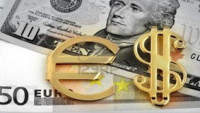 Here are the latest developments in global markets:
Here are the latest developments in global markets:
FOREX: The dollar was slightly higher versus a basket of currencies, though it was losing ground versus the safe-haven perceived yen which attracted flows on the back of uncertainty relating to global trade. Specifically, dollar/yen was trading at two-week low levels.
STOCKS: Asian equities were a sea of red after the latest concerns over global trade acted to the detriment of riskier assets. Japan’s Nikkei 225 and Topix indices finished lower by 0.8% and 0.95% correspondingly, while Hong Kong’s Hang Seng shed 1.3%. The negative sentiment looks set to reverberate into Europe with all major benchmarks set to open in negative territory. The same holds true for futures tracking the Dow, S&P 500 and Nasdaq 100; they’re all down by more than 0.5%.
COMMODITIES: WTI and Brent crude were lower at $68.52 and $74.51 per barrel respectively, after surging on Friday following OPEC’s agreement to a modest increase in production relative to what markets expected. In precious metals, gold was again unable to attract safe haven flows, perhaps owed to a US currency that remains relatively elevated; gold is denominated in dollars. The yellow metal was down by around 0.15% at $1,266.74 per ounce.
The dollar index, which gauges the greenback against the currencies of six major US trading partners, edged higher, though by less than 0.2%. Still, the US currency was coming under pressure versus the yen, as safe-haven flows on the back of uncertainty over global trade elevated the Japanese currency, at one point pushing dollar/yen to 109.35, its lowest since June 11.
Also despite trading higher, it is worth pointing that at 94.52, the dollar index was at a relative distance to last week’s 11-month high of 95.53.
US President Donald Trump threatened on Friday to impose a 20% tariff on cars imported from the EU. Adding insult to injury of rising trade tensions, was a report by the Wall Street Journal saying the US Treasury Department is working on blocking investments in US companies involved in “industrially significant technology” by corporations with at least 25% Chinese ownership.
Besides the fall in equities, the risk-off mood was also reflected by the falling Treasury yields; investors were seeking the safety of US government bonds.
Euro/dollar traded lower by around 0.15%, at 1.1640. Besides the trade spat with the US, other near-term drivers for the currency are expected to be Tuesday’s talks between German Chancellor Angela Merkel and the leaders of the other parties in her coalition government; immigration policy is seen as threatening her government.
Sterling was 0.2% down against the dollar ahead of an important EU summit on Brexit on June 28-29.
The commodity-linked aussie, kiwi and loonie, which tend to lose in a risk-off environment, were all lower against their US counterpart on Monday. The Canadian dollar was also sensitive to volatility in oil prices following OPEC’s supply decision.
In emerging markets, the Turkish lira was a big gainer, with dollar/lira trading lower by around 2% after Turkish President Tayyip Erdogan and his AK Party secured victory in Sunday’s presidential and parliamentary elections.

Monday’s calendar is a rather light one, with the Ifo business sentiment surveys for Germany, as well as new home sales data out of the US being the day’s important releases. Any trade updates would either way attract attention, but will perhaps be more closely watched in light of a calendar that is lacking much in terms of releases.
The Ifo Institute’s reports gauging business morale in Germany are scheduled for release at 0800 GMT. The business climate, current conditions and expectations indices are all anticipated to slightly ease compared to May’s respective readings and thus point to worsening sentiment in the eurozone’s largest economy. Specifically, the business climate index, which perhaps generates most interest, is projected to record its seventh monthly decline, while falling to its lowest since H1 2017.
Out of the US, new home sales are expected to have increased by 1.5% m/m in May, after declining by the same proportion in April. The numbers are due at 1400 GMT.
Of course, trade developments (discussed above) will also be eyed, having implications not just for currency markets, but also equities, bonds and commodities.

EURUSD has retreated a bit from Thursday’s 11-day high of 1.1674. The RSI remains in bullish territory above 50 – it is not far above this level – though it has halted its advance and is projecting a largely neutral picture in the short-term at the moment. The stochastics though are giving a bearish signal in the very short-term: the %K line has moved below the slow %D one and both lines are heading lower.
Upbeat views on Germany out of the Ifo surveys later today could boost the pair, with immediate resistance to gains possibly coming around the current level of the 100-period moving average at 1.1687; the area around this point includes the 1.17 figure that may hold psychological significance, as well as Friday’s high of 1.1674. Further above, the zone around the 1.1750 mark that encapsulates numerous tops and bottoms from the recent past and which was relatively congested in previous sessions, may act as an additional barrier to stronger bullish movement.
Conversely, worse-than-expected releases out of Germany may push EURUSD lower. Support seems to be taking place at the moment around the 50-period MA at 1.1630. A downside violation would turn the attention to the 1.16 handle for additional support.
Trade deliberations can also move the pair.
Origin: XM












